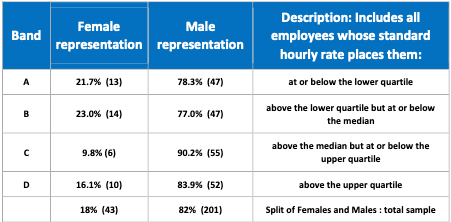Introduction
The aim of this report is to provide transparency regarding pay and representation of women in the workplace within SCCI Alphatrack – SCCIA. We have undertaken this report in accordance with the statutory disclosure requirements under legislation that came into effect in April 2017. However, SCCIA strongly believes that encouraging diversity and inclusion within our organisation is absolutely the right thing to do; offering equal opportunities and reward to women and men is just one area on which we are focusing our attentions.
Our core service offering is broadly based around the sale and provision of Engineering capabilities – an industry that has, historically, tended to attract men more so than women, particularly into technical / professional and, through progression, Leadership roles. Therefore, we consider our Gender Pay Gap to be influenced by this continuing dominance but SCCIA strives to encourage more women into our business, particularly into professional specialist 1and leadership positions. There is no reason why women should not be equally represented within the Engineering arena.
Across the SCCI Group, of which SCCI Alphatrack Ltd. is a member, we have an Executive Board with a female representation of 29%. We consider this to be a positive representation for our industry at Board level but, within this report specifically detailing data regarding male / female representation across SCCIA alone, you will note a higher proportion of men at all professional specialist and leadership levels of the organisation.
Our aim is to secure the right talent for our business irrespective of their gender. When we secure that talent, we will ensure that reward is based on ability - not gender - and opportunities are created based on the same criteria.
Louise Hutchings
Group HR Director, SCCI Group
Gender Pay Gap Findings
1. Mean gender pay gap = 12.1%
2. Median gender pay gap = 7.5%
3. Mean gender bonus gap = 38.4%
4. Media gender bonus gap = 3.2%
Whilst SCCIA does have a gender pay gap for both hourly rate and bonus payments, when we look at industry comparitors, we can note that:
Our mean gender pay gap of 12.1% for hourly pay is significantly below that of organisations in the private services sector (21.1%)3 and a similar industry, facilities, security and support services, (29.1.%).
Applying the same comparison to the mean gender bonus gap of 38.4% (our most significant gap in this report) we can see that private sector service organisations demonstrate a gap of 30% and for the similar industry we see a gap of 34.7%. A point to note is the proportion of females in receipt of a bonus compared to males: whilst the total amount of bonus (£) to them is lower overall compared to the overall award to males, the number of females in receipt of a bonus (64.3%) is significantly higher than males receiving a bonus (32.2%).
Pay Quartiles
As the title suggests, pay has been divided into four categories (quartiles) and the spread of female and male employees within each quartile assessed. For the purposes of this report we were required to look at SCCIA’s hourly pay rate for all full-pay relevant employees4 in the pay period covering 5th April 2017.
The results are summarised below:

The table clearly supports SCCIA’s consideration that male dominance of the Engineering arena still exists. From a data sample of 244 full-pay relevant employees, 82% or 201 of the sample are male. We can also identify, for each quartile, a significantly higher proportion of males which we believe to be influencing the Gender Pay Gap for both hourly and bonus pay.
Reasons for the gaps identified: general
Gender pay gap is a measure of the difference between men’s and women’s average earnings across an organisation: it is expressed as a percentage of men’s earnings.
In Britain there is an overall gender pay gap of 18.1%5 for a number of reasons:
The above list is not exhaustive but starts to give an indication of how a gender pay gap is in existence today.
As an employer, SCCIA will commit to ensuring women are recognised and rewarded in the same way as their male colleagues. We will provide careers that offer equal basic pay, bonus and development opportunities based upon contribution to the business. We recognise there is an underrepresentation of females in the Engineering environment and we will actively seek opportunities to promote and offer careers to women across our business. |

